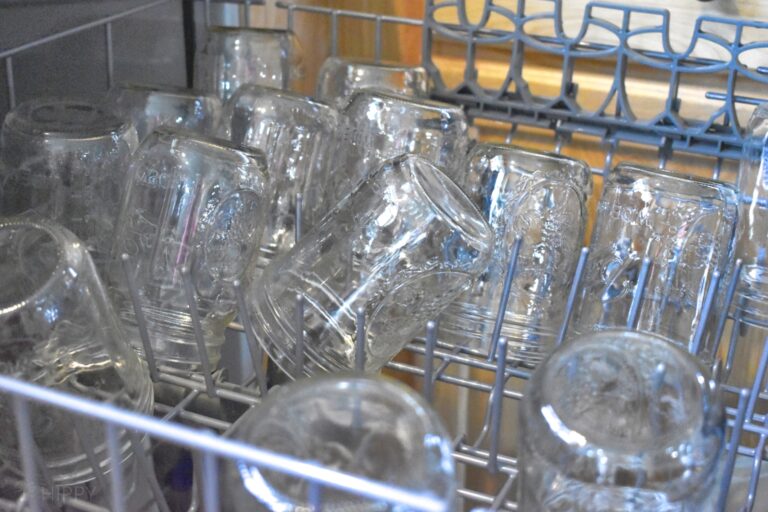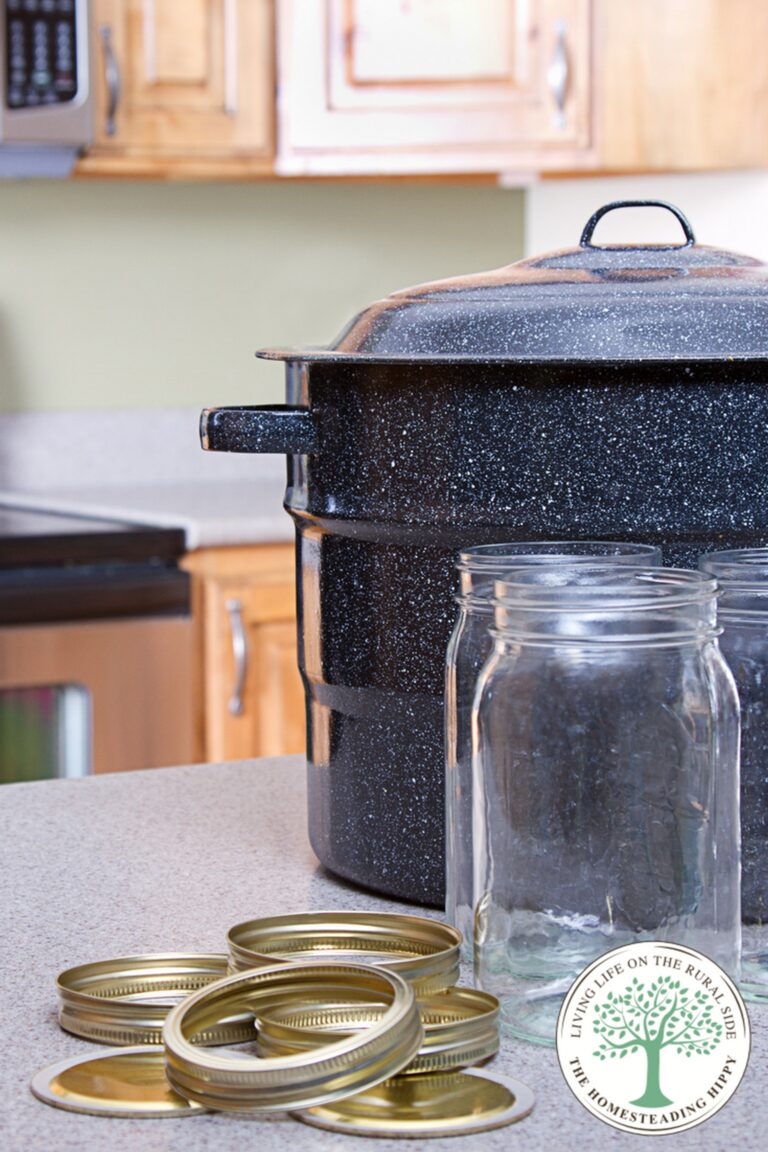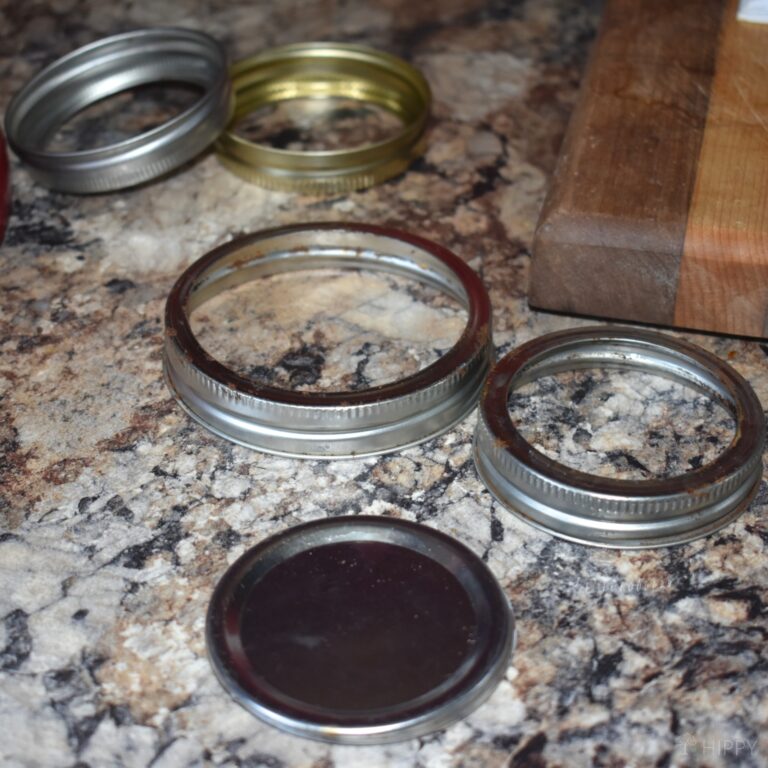Get ready to can your food safely! Here’s the list of essential home canning equipment you NEED, plus where to find it cheaply!
When it’s time to start preserving your garden produce, many homesteaders turn to canning.

This home food preservation method makes your food shelf and pantry stable, easily stored for a year or more, and makes meals that are easy to heat and eat.
If the power is out, you can still consume your home canned food, just open the jar and you are ready for a hearty meal.
Canning has changed since your Great Grandma did it. For example, she would seal a jelly jar with wax instead of putting the jar in a water bath canner.
Great Grandma may also have water bath canned her vegetables like green beans, potatoes, and peas. Today those foods are processed in a pressure canner.
She may have also not worried about adding extra citric acid to her homegrown tomatoes. Life was different back then.
Frankly, so was the soil. Most of us deal with mineral depleted soil, especially when first starting out.
Chemicals that eradicate weeds, and help the grass to grow are commonplace now. Even if you don’t do this yourself, runoff from your neighbor who DOES spray can and does happen.
Those chemicals can ruin even the best garden soil if given the chance. We need to take different precautionary measures when we are home canning now because of this.
Essential Home Canning Supplies
When you visit a link in this article that takes you to a different website where you can purchase something, I may earn a commission. Read my full disclosure for more details.
Water bath canner
While there are many different canning methods, one essential piece of equipment is a water bath canner.
As the name suggests, water bath canning involves submerging sealed jars of food in boiling water. This process is ideal for high acid foods such as fruits, tomatoes, and pickles.

The boiling water kills any bacteria that may be present, ensuring that your canned goods will be safe to eat.
In addition, the heat helps to seal the jars, creating an airtight seal that prevents spoilage. So if you’re planning on doing any home canning, be sure to invest in a reliable water bath canner.
Pressure canner
The pressure canner is one of the most important tools for the home canner. While it is possible to safely can low acid foods using a boiling water canner, the pressure canner provides an extra level of safety.
The high temperatures reached during the canning process help to kill bacteria and other microorganisms that can cause food spoilage.
In addition, the pressure canner creates a vacuum seal that prevents oxygen from entering the cans, further protecting the food from contamination.
For these reasons, any home canner should have a pressure canner in their arsenal of essential equipment.
Jars
Perhaps the most important piece of equipment for home canning is the jar. Canning jars must be made of heat-resistant glass and have a specialized lid with a sealing compound.
The most common type of canning jar is the Mason jar, which was first introduced in 1858. Today, Mason jars come in a variety of sizes (1/2 pint, pint, 1 1/2 pint, quart, 1/2 gallon), from small half-pint jars to large gallon jars, in regular and wide mouth
Other popular types of canning jars include Ball jars and Kerr jars. Make sure you have both regular and wide-mouth jars on hand in a variety of sizes.
Bands
One of the most important items you need for home canning are bands. Bands are used to secure canning lids in place, and they must be strong enough to withstand the boiling temperatures of the canning process.

Bands can be reused, as long as they are still in good shape. However, if a band is damaged or shows signs of wear, it should be replaced to ensure a proper seal.
Lids
One of the most important items you need for home canning are lids. Canning lids must be brand new each time, or you risk false seals or seal failures.
The exception to the lids would be hard reusable ones. Without a proper seal, your canned goods will not be safe to eat.
Jar lifter
If you’re planning on doing any home canning, then you’re going to need a jar lifter. A jar lifter is a tool that helps to remove hot jars from canners, and it’s an essential piece of equipment for anyone who wants to preserve their own food.
The jar lifter is designed to fit around the neck of a canning jar, and it has a series of prongs that grip the jar securely.
This way, you can lift the hot jar out of the canner without risking burns or spills. Jar lifters are inexpensive and easy to find, so there’s no excuse not to get one before you start your next canning project.
Hot Pads
One essential item is a set of hot pads. Canning involves boiling jars of food in water, and the hot jars can be difficult to handle without proper protection.
Hot pads provide a layer of insulation between your hands and the hot jars, making it much easier to move them around.
In addition, they can also be used to help keep the jars from sliding around on the countertop while they’re cooling.
Towels
When canning at home, towels are an important item to have on hand. They can be used to set hot jars on to cool, and to wipe up any spills that may occur. In addition, towels can be used to protect surfaces from the heat of the canning process.
When selecting towels for home canning, look for ones that are durable and absorbent. Also, be sure to choose a size that will allow you to easily wrap around hot jars.
Timer
One of the most important supplies for home canning is a timer. Processing times for canned foods are critical, and even a few minutes can mean the difference between safe, delicious food and spoiled products.
A timer will help ensure that your canned goods are properly processed, and will also help you keep track of how long they’ve been in the canner.
Keep in mind most pressure canning recipes have a 50 to 100 minutes processing time, so b sure to get a timer that is able to track more than 1 hour (as most of them are not).
Vinegars
While you can use any type of vinegar, white vinegar is the most popular choice for canning. Apple cider vinegar is used in many recipes as well.
Salts
Most people are familiar with the basic items needed for home canning, such as jars, lids, and a boiling water canner. However, there are a few other items that are essential for the home canning process, including pickling salt and canning salt.
Pickling salt is a fine-grained salt that is free of additives, such as iodine. Canning salt, on the other hand, is a coarse-grained salt that has been fortified with iodine.
Both types of salt are necessary for pickling and canning food, as they help to preserve flavor and prevent bacterial growth.
Sweeteners
Sweeteners are an important component of home canning. They help preserve the color and flavor of fruits, and they also prevent mold growth. sugar, honey, and corn syrup are all commonly used sweeteners for home canning.
Each has its own unique flavor that can enhance the taste of canned fruits.
However, it is important to use the proper amount of sweetener to avoid ruining the fruit. Too much sugar can make fruit syrupy and difficult to eat, while too little sugar can cause fruit to spoil quickly.
As a result, it is important to follow recipes carefully and only use the amount of sweetener specified.
Spices
You’ll need some spices – choose whatever you like, but be sure to include things like salt, pepper, and cinnamon.
Pectin
Pectin is a natural compound found in fruit that helps to thicken jam and jelly. You can find pectin at most grocery stores, or you can make your own by boiling down apples or other fruit.
Canning Books
Canning books are an essential item for anyone interested in home canning. While there are many resources available online, nothing can replace the wealth of information found in a good canning book.
Canning books will provide you with step-by-step instructions on how to properly can various foods. In addition, they will also offer guidance on the best techniques for preserving different types of food.
Steam Juicer
A steam juicer works by heating up water to create steam, which in turn heats up the fruit or vegetables you are trying to preserve.
This process helps to kill any bacteria that may be present, as well as extract all of the natural juices from the produce. As a result, your preserves will be not only more flavorful, but also safer to eat.
Victorio food mill
The Victrolo food mill is an essential piece of equipment for any home canner. It is used to puree fruits and vegetables, which makes it ideal for making jams, jellies, and preserves.
The food mill has a perforated disk that is attached to a handle. The disk has different-sized holes that allow different-sized pieces of fruit or vegetable to pass through.
The handle is turned in a clockwise motion, which rotates the disk and forces the fruit or vegetable through the holes.
The pulp and skins are caught on the outside of the disk, while the pureed product is collected in a bowl on the underside of the mill. The Victrolo food mill is easy to use and clean, and it is an essential piece of equipment for any home canner.
Hand food mill
A hand-operated food mill is a useful tool for home canning. It can be used to process large batches of fruits and vegetables at one time. This is especially helpful when you are trying to preserve a large harvest from your garden.
A food mill will save you time and effort by quickly and easily grinding up all of your produce. Plus, it will give you a chance to make some delicious homemade sauces, soups, and baby food!
Dutch Oven or Large Stock Pot
One of the most important items you will need is a Dutch oven or large stock pot.
This pot will need to be big enough to fit all of your food you are preparing, as well as have room for boiling water. In addition, it is important to use a pot with a heavy bottom in order to prevent scorching.
Air Bubble Tool
One essential piece of equipment is an air bubble tool. This tool helps to release any trapped air bubbles in the jar before sealing it.
Without an air bubble tool, your jars could be at risk of exploding. In addition, an air bubble tool can help to ensure that your food is properly sealed.
Mixing Bowls
One of the most important items you’ll need is a set of mixing bowls. Canning involves boiling foods in large pots of water, so you’ll need a bowl that can hold at least four quarts.
It’s also important to have a second, smaller bowl for prep work like washing produce or measuring spices.
Look for bowls made of durable materials like glass or ceramic, as these will last longest and won’t react with the acidic foods you’ll be canning.
Sharp Knives
Sharp knives are a necessity for canning, as they allow you to quickly and easily slice through food.
A dull knife, on the other hand, can cause bruising and damage to the food, making it more difficult to preserve. In addition, sharp knives are less likely to slip, making them much safer to use.
Tongs
You’ll need some canning tongs to help lower the hot jars into the boiling water.
Measuring Cups
Measuring cups are one of the most important items you need for home canning. They allow you to accurately measure the amount of fruit or vegetable you need to fill a jar, which is essential for ensuring that your food will be safely processed.
Measuring cups also come in handy when making adjustments to recipes, such as when you need to add more or less sugar.
While you can find measuring cups made from a variety of materials, including plastic and metal, glass is the best option for home canning because it is non-reactive and won’t absorb odors or flavors from the food.
Likewise, glass measuring cups are also easy to clean and can be reused over and over again.
Whether you’re a beginner canner or a seasoned pro, make sure to have a good set of measuring cups on hand to make your home canning experiences successful and safe.
A Slotted Spoon
A slotted spoon is one of the most versatile tools in the kitchen. Its long handle and perforated bowl make it perfect for scooping up vegetables from a boiling pot, and its slots allow liquids to drain away, making it ideal for serving pasta or removing meat from a stew.
Slotted spoons can also be used for mixing ingredients, as the slots help to evenly distribute liquids throughout a dish.
In addition, slotted spoons are often used for canning, as they can be used to remove hot jars from a canner or water bath.
A Ladle
A ladle is used to transfer hot liquid from the canning pot to the jars. It is important to choose a ladle that is made of heat-resistant material, such as stainless steel or glass, to avoid melting or warping.
The handle should also be long enough to keep your hand safely away from the heat.
Strainer or Cheesecloth
You need to have a strainer or cheesecloth on hand to ensure that your fruits and vegetables are free of dirt and debris.
Otherwise, you run the risk of contaminating your food. A cheesecloth is particularly useful for removing small seeds and bits of pulp from your produce.
Canning Funnel
A canning funnel is one of the most essential tools for the job. Canning funnels have a wide mouth and a tapered design, making them ideal for filling canning jars quickly and neatly.
They also have a lip that extends over the jar opening, preventing spillage. In addition, canning funnels are handy for removing hot food from canning jars.
Canning Rack
One of the most important items you’ll need is a canning rack. This is used to hold the jars in place during processing.
Canning racks come in various sizes and shapes, so you’ll need to choose one that will fit your canner. Y
you’ll also need to consider how many jars you want to process at one time. If you plan on canning large quantities of food, you may want to invest in a multiple-level canning rack.
Canning racks are made of different materials, including metal and plastic. Some are even dishwasher safe. When selecting a canning rack, be sure to choose one that is durable and easy to use.
Magnetic Lid Wand
You’ll need a magnetic lid wand. This handy tool helps to remove the hot lids from the boiling water without burning yourself.
Kitchen Scale
A kitchen scale is an essential tool for any home canner. Measuring the ingredients for canning recipes is important to ensure that the food will be properly preserved.
A kitchen scale also comes in handy when portioning out foods to be canned.
For instance, if you are canning tomatoes, you will need to know how many jars to prepare based on the amount of tomatoes you have.
A scale can help you to determine the right proportions so that your food will turn out perfect every time.
Colander
There are plenty of items that you will need in order to get started, but one of the most essential is a colander.
A colander is a large, bowl-shaped strainer that is used for draining and rinsing food. It is the perfect tool for washing fruits and vegetables before canning them, as it allows you to quickly remove any dirt or debris.
Cutting Boards
One of the most important items you will need is a cutting board. A cutting board provides a safe and stable surface for chopping fruits and vegetables. It also helps to protect your countertops from knives and other sharp objects.
When choosing a cutting board, look for one that is made of durable material such as hardwood or bamboo.
Avoid cutting boards that are made of glass or plastic, as these can easily be scratched or gouged. For added safety, choose a cutting board with a non-slip surface.
Where To Get Cheap Home Canning Supplies
Home canning equipment that is reusable such as jars, canners, and bands can be obtained quite cheaply if you know where to look. Try:
- Yard sales
- Estate Sales (often the best source, in my opinion)
- Thrift Stores
- Craigslist
- Asking Great Grandma for her stash
- Amish Bulk Store
Things to Watch Out for When Purchasing Used, Cheap Home Canning Supplies
- Check for cracks in the jars, especially on the upper mouth
- Pressure canners should have working seals and all the weights
- Water bath canners need to be free from rust or holes in the bottom.
- Bands should be rust free, and in good, round shape
- Blue jars are pretty, but the metal lids that came with them will most likely need new gaskets.
Home canning equipment doesn’t have to cost an arm and leg to get started, either. Simply start with one canner, a few jars, and add to your collection when you can.
Share in the comments your favorite piece of canning equipment and where you got it!

Heather’s homesteading journey started in 2006, with baby steps: first, she got a few raised beds, some chickens, and rabbits. Over the years, she amassed a wealth of homesteading knowledge, knowledge that you can find in the articles of this blog.
Learn more about Heather and the rest of the writers on this page.

Thank you for the canning info. I’m not a homesteader, and am relatively new to canning, having only one ‘season’ of experience, a few years ago. So far this year, I’ve canned Hot Pepper Hoagie Relish (from the Food in Jars blog), and Jardineira, Traditional Bread and Butter Pickles, and Herb Seasoned Tomatoes, all from the Ball Book. I was using a tall stainless steel stock pot with a rack in the bottom, which worked just fine, except for capacity. I could only fit four quarts or five pints in the stock pot. Last week I finally purchased a real canner (from Amazon): Stainless Steel Multi-Use Canner with Temperature Indicator by VICTORIO VKP1130. ( The price was $62 when I purchased. ) In addition to the extra capacity, I can also steam can, which I’d never heard of until a few weeks ago. After much searching, I found documentation that steam canning is safe, even citing this particular canner’s temperature gauge. I didn’t initially see the benefit of steam canning, but, after conducting the recommended initial temperature gauge test, and finding that bringing the canner full of water and jars up to temp for processing took fifty (!) minutes, I do. I love this canner, so far. Not to contradict the advice on the granite wear, which is a sound and economical purchase, If you can swing the cost…get this. With care, I don’t think this pot will ever wear out.